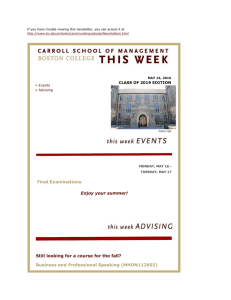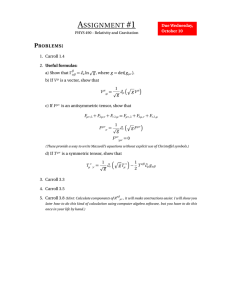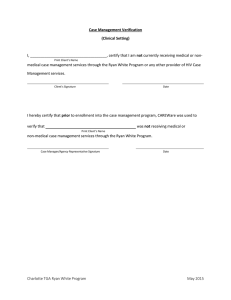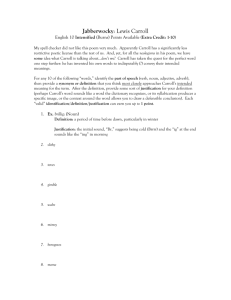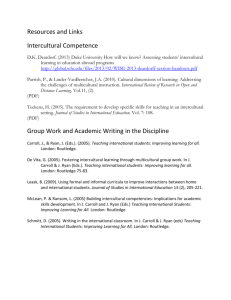Ten Tips for Teaching International Students
advertisement
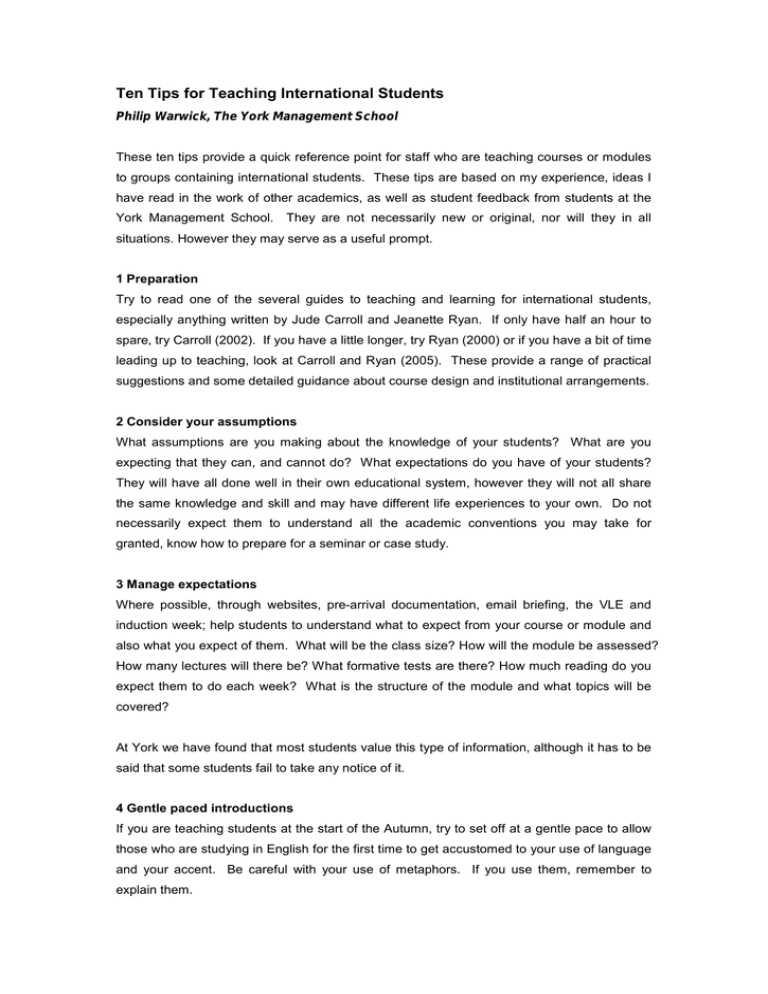
Ten Tips for Teaching International Students Philip Warwick, The York Management School These ten tips provide a quick reference point for staff who are teaching courses or modules to groups containing international students. These tips are based on my experience, ideas I have read in the work of other academics, as well as student feedback from students at the York Management School. They are not necessarily new or original, nor will they in all situations. However they may serve as a useful prompt. 1 Preparation Try to read one of the several guides to teaching and learning for international students, especially anything written by Jude Carroll and Jeanette Ryan. If only have half an hour to spare, try Carroll (2002). If you have a little longer, try Ryan (2000) or if you have a bit of time leading up to teaching, look at Carroll and Ryan (2005). These provide a range of practical suggestions and some detailed guidance about course design and institutional arrangements. 2 Consider your assumptions What assumptions are you making about the knowledge of your students? What are you expecting that they can, and cannot do? What expectations do you have of your students? They will have all done well in their own educational system, however they will not all share the same knowledge and skill and may have different life experiences to your own. Do not necessarily expect them to understand all the academic conventions you may take for granted, know how to prepare for a seminar or case study. 3 Manage expectations Where possible, through websites, pre-arrival documentation, email briefing, the VLE and induction week; help students to understand what to expect from your course or module and also what you expect of them. What will be the class size? How will the module be assessed? How many lectures will there be? What formative tests are there? How much reading do you expect them to do each week? What is the structure of the module and what topics will be covered? At York we have found that most students value this type of information, although it has to be said that some students fail to take any notice of it. 4 Gentle paced introductions If you are teaching students at the start of the Autumn, try to set off at a gentle pace to allow those who are studying in English for the first time to get accustomed to your use of language and your accent. Be careful with your use of metaphors. If you use them, remember to explain them. 5 Group work I suggest you manage group composition, even though this may not initially be popular. Nevertheless this benefits students because they are forced to have experience of cross cultural group work. This requires preparation in advance of the first exercise to set up the groups. Once the students are in their groups, encourage them to stay in these groups for a meaningful number of sessions. Ensure that the initial group work is formative and give the group the opportunity to get to know each other. Let the students know that you expect them to learn from the process of working in a group and that, in the first few exercises, the process is as important as the end result. 6 Encourage speaking in class The way you receive the first few class contributions is very important for the class dynamics as the module develops. Welcome all contributions and try not to be critical of any comments made (see Buttner 2004). If a student has misunderstood the point, thank them for their contribution and try to encourage another student to offer an alternative point of view. Be explicit about encouraging all contributions and remind students that obtaining a range of view points is helpful to them because they need to understand there are always arguments for and against different approaches in business. Students who are reluctant to give their own views might be prepared to feedback an idea which they have talked about with peers. 7 Case Studies It might be tempting to use case studies with which you are familiar. But if you use case studies that are based in the UK, home students will always be in a stronger position respond than international students. Wherever possible, use cases with a multi-national context that do not favour the contextual knowledge of the home students. Alternatively, use a case that forces home students to seek contextual understanding from international students (as an example please see the Li Ning Case study which is available on the BMAF website at………….). 8 Assessment Strategies Be clear about what you want students to do in assessments. Try to set assessment questions in a way that does not favour one group over another. For example, if you want an assignment to be in report form, make sure that you have been explicit about what you consider to be an appropriate format during the module or in the assessment guidelines (preferably both). Write your assessment questions (especially examination questions) in straightforward language. Those with English as a second language may waste valuable time during the examination trying to understand exactly what the question means, if you write in a complicated academic style. You can generally convey the same meaning in plain English using fewer words. 9 Get to know your students Acknowledge and celebrate the diversity of the class. For example, you can ask the group to comment on the activities of multi-national companies in their home countries or ask the students to provide examples of multi-national organisations that operate in their countries of origin. This may make for more active participation and a more rewarding experience for the student. 10 Make time to reflect on how it went Talk to colleagues about what was successful and what was less so. They may be able to assist you in the process of review and reflection Carroll, J. (2002) Suggestions for teaching international students more effectively, OCSLD, Oxford Brookes University, available on line at: http://www.brookes.ac.uk/services/ocsd/2_learntch/briefing_papers/international_students.pdf (accessed 27/07/09) Carroll, J., and Ryan, J. eds. (2005). Teaching International Students – Improving Learning For All, Abingdon, Routledge Buttner, E. (2004) How do we ‘dis’students?: a model of (dis)respectful business instructor behaviour, Journal of Management Education 28,3, 319-334. Ryan, J. (2000) A Guide to Teaching International Students, Oxford, Oxford Brooks University This work is licensed under a Creative Commons Attribution-NonCommercial 3.0 Unported License.
